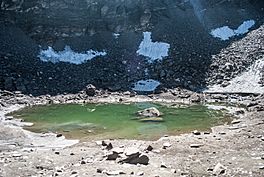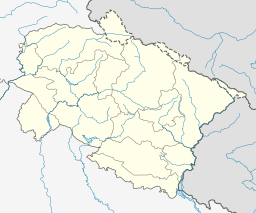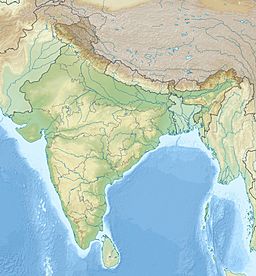Roopkund facts for kids
Roopkund is a mysterious glacial lake high up in the Himalayas of India. People often call it Mystery Lake or Skeleton Lake. It is located in the Uttarakhand state, surrounded by tall, snowy mountains and rocky areas. The lake is very high up, about 5,020 meters (16,470 feet) above sea level. Not many people live near it.
Roopkund is a popular place for trekking, which is like hiking long distances. The lake changes size, but it's usually less than 40 meters (130 feet) wide. In winter, the lake freezes completely. It is about three meters (10 feet) deep.
The lake is famous because hundreds of old human skeletons have been found there. You can see these bones at the bottom of the lake when the ice melts. At first, people thought a single group of travelers died in a big hailstorm a long time ago. However, scientists later found that the skeletons belong to different groups of people. They died at different times, around 800 CE and 1800 CE. Because of these bones, the lake is now known as "Skeleton Lake."
Contents
Discovering the Skeletons of Roopkund
The skeletons were found again in 1942 by a forest ranger named Hari Kishan Madhwal. He worked in the Nanda Devi National Park. When the British authorities first heard about the bones, they worried it was a hidden Japanese invasion force. But they soon realized the skeletons were much too old to be soldiers from that time.
You can see the skeletons in the clear, shallow water of the lake for about one month each year. This is when the ice melts away. Along with the bones, people also found old wooden items, iron spearheads, leather slippers, and rings. In 2003, a team from National Geographic collected about 30 skeletons. Some of these still had bits of flesh attached to them.
The Legend of King Jasdhaval
Local stories tell a sad tale about the lake. The legend says that King Jasdhaval of Kanauj was on a pilgrimage. He was traveling to the Nanda Devi shrine with his pregnant wife, Rani Balampa. Their servants and a dance troupe were also with them. The story says that a terrible storm with huge hailstones hit them near Roopkund Lake. Everyone in the group died in the storm.
Who Were the People of Skeleton Lake?
Scientists have found remains from more than 300 people at Roopkund. The Anthropological Survey of India studied some of these skeletons in the 1950s. You can see some samples at their museum in Dehradun.
Early studies showed that many of the skeletons had head injuries. Some researchers thought these injuries were caused by round objects falling from above. They believed this was the main reason people died. These scientists concluded that the victims were caught in a sudden hailstorm. This matched the old local legends and songs.
Later, scientists used Radiocarbon dating to find out when the bones were from. They also looked at the DNA of 38 skeletons. They found that the remains were from different time periods. They belonged to three separate groups of people:
- One group of 23 people lived around 800 CE. They had ancestors from South Asia.
- One person lived around 1800 CE. This person had ancestors from Southeast Asia.
- Another group of 14 people lived around 1800 CE. Their ancestors were from the eastern Mediterranean, like modern-day Greece and Crete.
These new findings show that the people did not all die in one big event. The older bones from South Asia were likely left there over a long time. The younger bones from the Mediterranean and Southeast Asia were probably left during a single event.
Protecting the Skeletons
People are worried that the skeletons are slowly disappearing. Tourists often take bones as souvenirs. If nothing is done, the skeletons might vanish completely. Local officials have asked for the area to be protected. They want to stop tourists, trekkers, and researchers from taking the bones. The government is trying to make Roopkund an eco-tourism spot. This way, they hope to protect the skeletons and the area.
Visiting Roopkund: A Trekking Adventure
Roopkund is a beautiful place for tourists and a popular spot for trekking. It is located in the Chamoli District of the Himalayas. The lake is near two tall Himalayan peaks: Trisul (7,120 meters or 23,360 feet) and Nanda Ghunti (6,310 meters or 20,700 feet).
A rock face called Junargali is to the north of the lake. To the east is a peak named Chandania Kot. Every autumn, a religious festival is held at the nearby alpine meadow of Bedni Bugyal. Villages from around the area take part in this festival. A much larger celebration, called the Nanda Devi Raj Jat, happens every twelve years at Roopkund. During this event, people worship the Goddess Nanda.
The lake is covered with ice for most of the year. The best time to trek to Roopkund is in autumn, usually from mid-September to October.
See also
 In Spanish: Roopkund para niños
In Spanish: Roopkund para niños
- List of unsolved deaths





